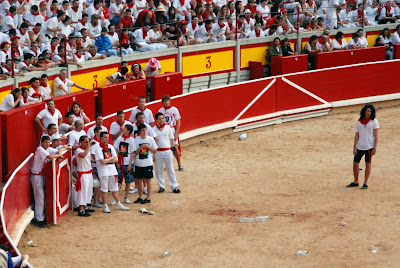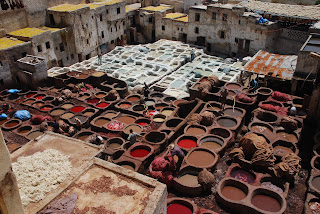Pamplona: The Thrill of Running with the Bulls
 |
A brilliant Life Magazine photo from the day of my 1st run
|
En caso de mala emergencia, llame por teléfono por favor a mi hermano, Brion, en Canadá +1 613 555 1234 o +1 613 555 4321. Él habla inglés solamente.
 |
Runners Awaiting the cohete
|
 |
One of my bulls in the afternoon
|
The fiesta from the night before is just winding down (though a new party will start as soon as the bars are swept) and those without hotel rooms are starting to head to the parks or scout out resting places in the myriad of public plazas nearby. Clean up crews are hard at work hosing down urine-soaked alleyways and power-washing away truckloads of broken wine bottles, beer cups and food wrappers that have accumulated over the past 24 hours. I dodge the street sweepers and those still partying and make my way towards the bullring.
 |
Crossing Mercaderes
|
The route starts at the corral on the outskirts of the city, in the shadow of the ancient ramparts. The first 293 yards run steeply uphill along Cuesta de Santo Domingo. It’s very narrow here, and the bulls run tightly in a pack. This is the first time in their lives that they’ve been exposed to more than the handful of vaqueros that tended to them on the range or tested them to see if they had the courage to be fighting bulls. It’s considered a dangerous section, yet some of the most experienced runners begin here by running directly at the bulls when they’re released to get clear of the crowds, then some turn at the last moment and run back uphill with the herd for as long as they can keep up. It’s aptly named the “Suicide Run.”
 |
| The Route |
 |
Heading into La Curva
|
 |
Old pic of a pileup in Callejón
|
__________________
The mood as I walk from the end of the route towards the beginning is an odd mix of emotions. The booze-fuelled, devil-may-care celebrations of the weary revellers still mingling on the street – many still carrying huge cups of Sangria – contrasts with the excited but serious looks of the corredores – the runners. In an hour there will be pure mayhem on these very cobblestones. As I pass through the streets, I’m visualizing my run, anticipating where I think the bulls will be, and making mental note of where things might go wrong. I look for recessed doorways and other possible avenues for escape, and notice where the bright sun shoots between buildings into the eyes of the runners. My anxiety is higher than normal but to my surprise, I have little fear. Perhaps that is a side effect of my slightly obsessive preparation. I’d watched dozens of hours of video, studied the route in Google Earth, read every article I could get my hands on, and viewed the section that I was about to run from a balcony the day prior. Still, part of the allure of the run is that anything can happen.
Without a few thousand humans to dodge, running with the bulls would be little more than a simple math problem:
With the size of the crowd this morning, you can throw that theory out the window. This is the weekend that the French cross the Pyrenees and come to town so the number of people more than doubles – twice the number of targets for the bulls and for people to trip over. Ending up on the end of a bull’s horn is the most traumatic injury, though it’s all those other runners that pose the greatest risk in the encierro. Sure, the gorings get all the press, but most of the injuries are a result of falls.
- Bull leaves Point A, running x km/hr
- Runner leaves Point B, running y km/hr
- They intersect at Point C
- Therefore, runner should choose Point B so that C occurs in a safe place with lots of escape routes.
__________________
Today is July 10, 2010.
As I wait for the cohete (rocket) to blast (once to warn runners that the bulls have been released, the second to indicate all bulls are clear of the pens and on the route) a man is handing out pañuelos to the runners anxiously gathered along Santo Domingo. They are simple red fabric triangles with text in small white letters on one side. The chap from New Mexico standing beside me says something about it being advertising. I glance at the one in my hand and suggest that he look a little closer. There is a slogan in Spanish with fifteen names below it. The last name is Daniel Jimeno Romero and below it, the date July 10, 2009. One year ago this morning, in the final stretch before the ring, an 1130-pound red-coloured bull named Capuchino took Daniel’s life. He was the fifteenth man to die in this run since they began keeping records in the 1920s and what frightens me the most is that he was no rookie. Daniel had run in over 80 encierros before that fateful day. I later learned that as we were being handed these pañuelos, Daniel's dad was further up the route, tearfully tying a pañuelo around the barrier at the exact spot where his 27 year-old boy entered mortality.
My heart dropped as the significance of this symbolic piece of cloth resonated within me and I thought about the crushing loss that Daniel's family must feel.
__________________
08:00:16
The instant the second rocket is launched, I see absolute, unmitigated terror in the eyes of many of the people who are running straight at me. Others are already cowering in doorways or crowding up against the inside of corners and I ask myself, why are they here? Perhaps they were too cheap to rent balcony spaces or were unwisely cajoled into running by so-called friends who questioned their masculinity. Maybe there are other reasons that I just don’t understand. As long as they stay out of my way, I’m happy.
[If you're going next year, Pamplona Man (San Fermin Travel Central) is the guy to talk to for help with scarce San Fermin accommodations, balcony rentals, bullfight tickets, etc. He was a huge help to me.]
There is literally a stampede of panicked runners hurtling past my spot on Mercaderes. I start to jog, looking back over my shoulder. The screaming of the crowd gets deafening and I can now hear the rapid jangle of the cowbells that are tied around the necks of the steers. I catch my first glimpse of them through a gap in the crowd as they exit Town Hall Square. By now, I’m completely focused and don’t hear or see anything that I don’t need to. I’m running as fast as I can without crashing into the people in front of me and in a heartbeat the bulls are alongside me. They are very fast and no one is stepping directly in front of them to slow them down. I try desperately to keep up and after several seconds beside the beasts, I realize I’m about to be exactly where I said I’d never go – the outside of La Curva! I peel off to the left side and as I watch the bulls careen through the corner, I notice the crowd is still running at me. Otra toro! The herd had already become separated and there were more bulls coming. I scan the crowd, sprint across the inside of the corner, and start running up Estafeta. Seconds later two more magnificent fighting bulls with rippling muscles, shiny jet-black coats and razor sharp upturned horns, are scattering the crowd like Moses parting the Red Sea. They’re right beside me now and I’m committing every ounce of energy I have into keeping close. My thighs are screaming, my lungs are burning and I haven’t run like this in twenty years.
And then they were gone. I slowed to a jog, then a walk, but my spirit is still soaring beyond the clouds. I’m filled with an indescribable feeling of pure jubilation from having completed this legendary run. I feel more alive than I have ever felt in my life.
I was certain I’d never make it to the ring before they slammed the gates shut so I strolled the rest of the way up Estafeta, absorbing the sights and sounds, watching groups of runners start to animatedly describe their adventure to others. The third rocket blast sounded announcing that all the bulls were in the ring, followed 10 seconds later by the final rocket confirming they were all safely locked away in their pens. The entire run took 2 minutes and 53 seconds – a clean and quick encierro.
It takes a couple of minutes for me to reach the top of the street and I pass the spot where yesterday medical crews had been treating a runner in his mid twenties with an angry-looking puncture wound to his side. I’m thinking of heading over to Bar Txoko for a celebratory morning drink, as a few people start to jog past me. I think to myself “forget it guys, the bullring is shut.” Moments later more are passing. They’re running now and again I hear the jangle of bells. What’s going on? I was positive I’d heard the fourth rocket! Suddenly, there they are – two huge steers coming around the bend onto Telefonica in full gallop. The steers are not wild animals like the fighting bulls so they’re less dangerous, but they still carry horns as wide as a compact car and you don’t want to get in their way. If you doubt me, just ask the lad who was knocked unconscious by one at the entrance to the ring during yesterday’s run. The steers had been held back in case they were needed to help guide any rogue sueltos to the ring.
I’m running again, right alongside them and they're within reach of the rolled up newspaper that I’m still carrying in my left hand. Across Telefonica we sprint and straight through the Callejón. When we burst out of the darkness of the tunnel and into the blinding sun of the bullring, the ground seems to vibrate with the roar of 20,000 people who have gathered inside to watch the run. With the crowd cheering wildly, I throw my arms up in triumph and suck up the overwhelming glory of my first encierro. It would not be my last. Hemingway would have been proud of me today. I'm sure of it.
Viva San Fermin!
 |
Crowd playing with a two-year old cow in the plaza
|











Ok I finally found myself taking a breath!! jesus, I can only imagine (no i can't who am i kidding!!!)
ReplyDeleteWhat an unbelievable moment that must have been ..... cannot wait to hear about the next!!
Amazing B& W shot there!
ReplyDeleteGilles
An exhilarating piece!
ReplyDeleteThe intersection of life and death, courage and poseurs ("The Brave Ones" hahaha), past and present...convey what must have been an overwhelming experience.
Peter